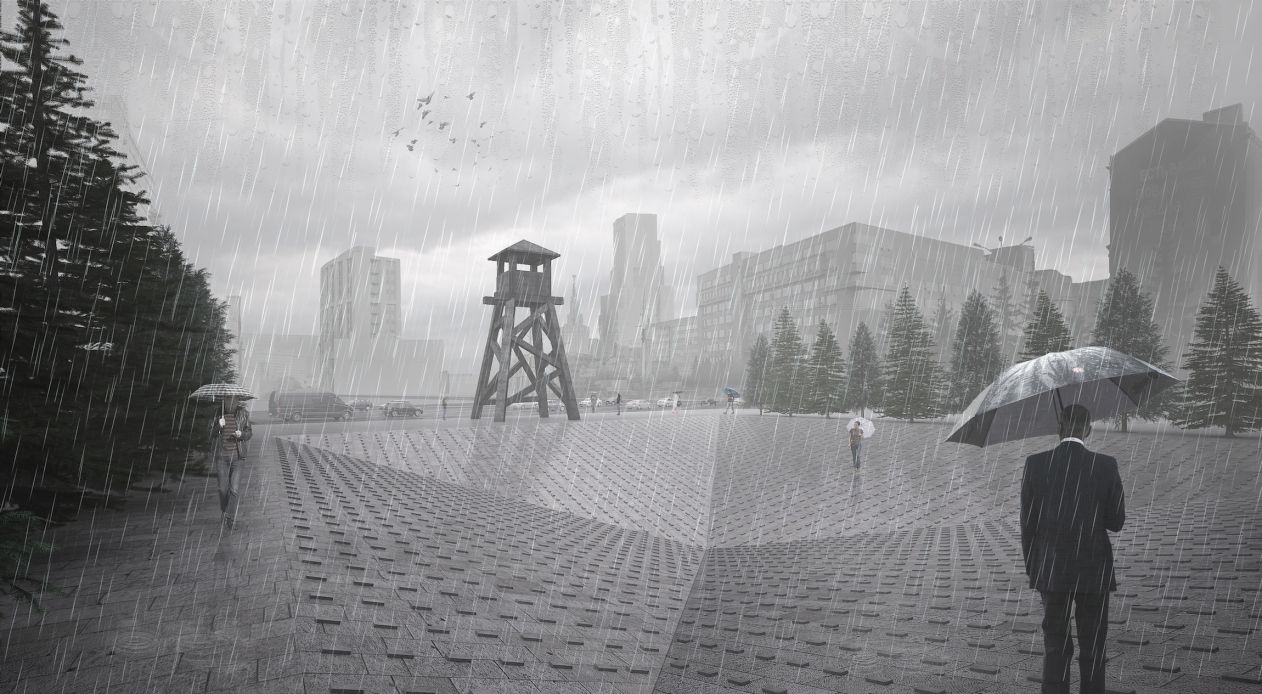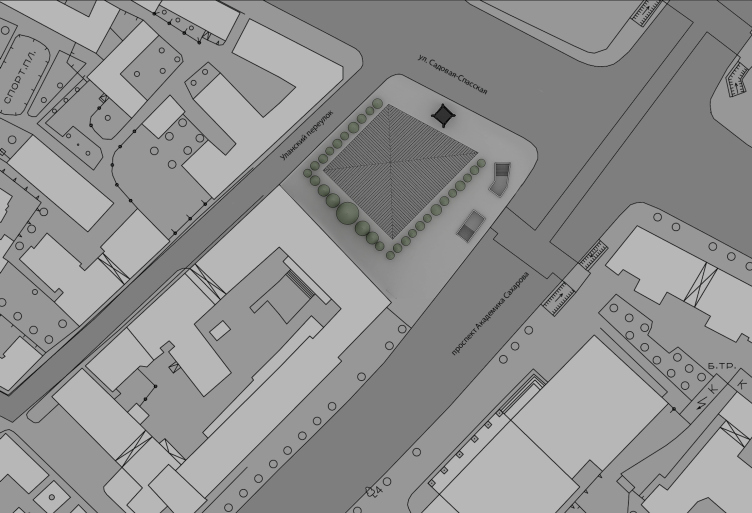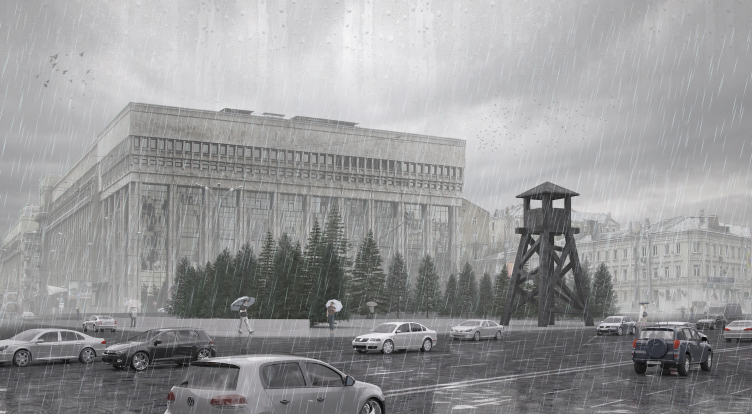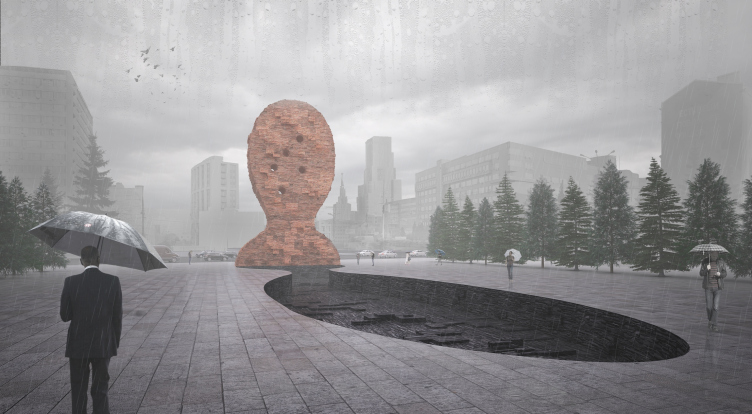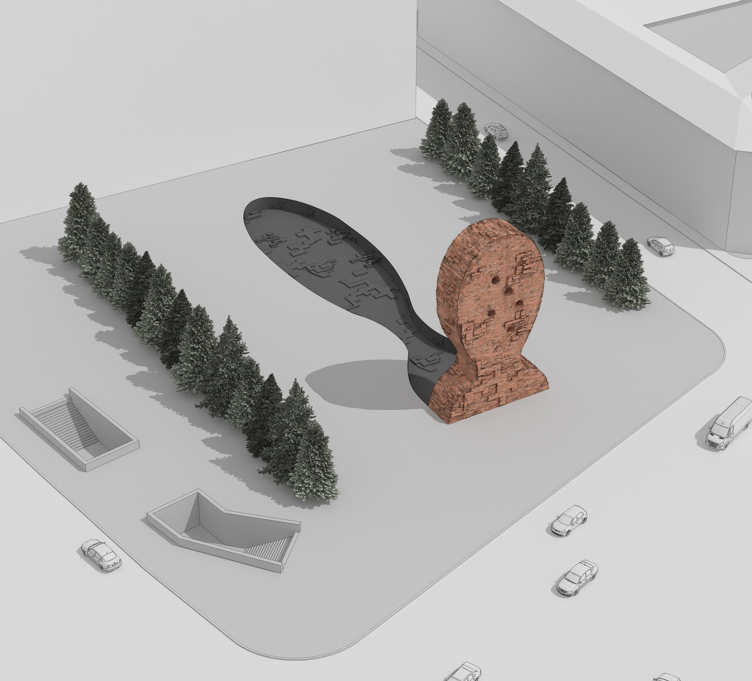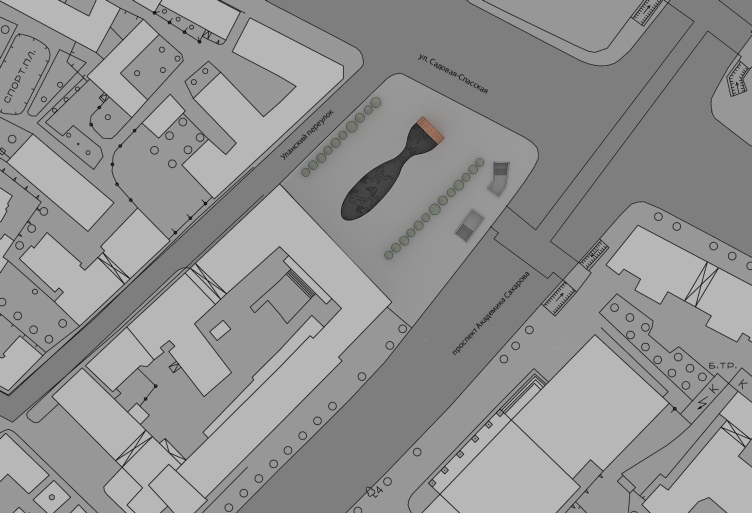The monument proposed by Arch Group and the sculptor Igor Shelkovsky did not get shortlisted as a winner of the contest for the best memorial to the victory of political repressions - but it still is worthy of attention if for no other reason then for the fact that the authors combined and at the same time spaced apart two main constituent parts of virtually any monument: the architectural and the sculptural, making each of them expressive and dramatic. Both versions consist of two parts - the "volume" and the "space" ones, meant to affect the viewer in two different ways and acting, on the one hand, together, and, on the other hand, separately, or even, to a certain extent, taking turns, like partners giving each other time to rest but still keeping up the viewer's attention.
In both versions, the "spatial" constituent part is the square territory left almost open and surrounded by fir trees on three sides: the architects propose to keep the trees intact, adding even more trees in front of the building of the former computer and now a business center - thus, shielding the monument away from it. The firs make up a wall and become part of the composition. As for the sculpture, it stands forward on the sidewalk, as close as possible to the Garden Ring road, so as to be more noticeable to the drivers and for the rare pedestrians.
In each of the cases, the sculpture is the main part of the monument, and the input to the project from Igor Shelkovsky, the hero of Moscow underground of the sixties, a conceptualist, a social artist, the founder of "А–Я" magazine, and a person of an unprecedented inner freedom" - is crucial for this particular project. Shelkovsky's father was repressed in 1937, when the future artist was but two years old, and at some point the labor camps and repressions became one of the main themes of his creative work. For him, the monument to the victims of repressions is filled with a deeply personal meaning. One of the ideas of the monument - the human head - was shown by Shelkovsky back in June at "37" exhibition in Moscow's GULAG history museum.
Project of the memorial to the victims of the political repressions on the Sakharov Avenue. Version 1: "Machine-gun tower" © Arch group
Project of the memorial to the victims of the political repressions on the Sakharov Avenue. Version 1: "Machine-gun tower". Location plan © Arch group
The first version is about a forced labor camp. Its sculpture is a giant fifteen meter tower, the height of a five-story house. To the right of it, as we drive along, we see a four-story "old-Moscow" house; behind it, we see the seven floors of the former computer center; further on down the Sadovaya Street, there is an eight story house. And, finally, a laconic background would be provided by the cubic building built by Leonid Pavlov, fourteen stories high. Now, I don't know much about machine gun towers but I could risk a guess that they must be from two to five meters high, hardly more. So, what we see here is the magnifying scaling, a tower the size of the building neatly fitting in with its surroundings. It makes the driver and the passerby stop at some moment and put themselves into the victim's place, feeling the evil frown with their backs.
The square behind the gun tower is designed as a vortex - its facets are tilted a little and are specked with pebbles, each of these pebbles signifying ten thousand victims. Passing through this place would be hard and uncomfortable. But the main thing is - in the center of the faceted pit one could easily guess some terrible kind of "ant lion" that waits for its victims to fall down into its pit. The square becomes the territory of the victims that are "guarded" from all sides - by the "Kremlin-type" fir trees and by the giant gun tower capable of gunning down the entire nation. This square looks as if it either extracts all objects from it or inevitably grinds them to dust - and it's even scary to step on it, where everything turns into stones and figures, like an evil spell was cast over this land. A metaphor of a giant machine of destruction.
Project of the memorial to the victims of the political repressions on the Sakharov Avenue. Version 1: "Machine-gun tower" © Arch group
Project of the memorial to the victims of the political repressions on the Sakharov Avenue. Version 1: "Machine-gun tower" © Arch group
The second version is not even about a camp - it is about execution by firing squad. The sculpture is at the same place but this time it is a giant brick human head shot through in several places. The bricks signify the multitude of victims but here it is done without exact calculation. Behind the head, a "pit" shadow falls, looking very much like a grave and - quite unexpectedly - like an archeological site, signifying just how much information is still to be unearthed. And, to the fact that the massacred people were buried without anyone bothering to so much as to count them. And they have not gotten their due until now. And the fir trees in this version of the monument look like the firing squad ready to pull the trigger.
Project of the memorial to the victims of the political repressions on the Sakharov Avenue. Version 2: "Human head" © Arch group
These monuments are hard to talk about, the very subject being a hard one. One of the things that come to mind is the Auschwitz museum proposed by Arch Group for the appropriate contest. The two projects definitely have a lot in common but on this case, if we are to compare it to the Auschwitz museum, it is only the signs that remain: the gun tower, the emptiness, the human being. But the most dominant thing in both monuments is the emptiness that comes to stay. A space that got reborn after many people on this country got killed by other many people; a world rebuilt on nameless bones where some people never forgave themselves and some never repented. Is it any good taking people to these monuments? What goes on on their heads when they see them? A very strong metaphor, come to think of it
Project of the memorial to the victims of the political repressions on the Sakharov Avenue. Version 2: "Human head" © Arch group
Project of the memorial to the victims of the political repressions on the Sakharov Avenue. Version 2: "Human head" © Arch group
Project of the memorial to the victims of the political repressions on the Sakharov Avenue. Version 2: "Human head" © Arch group
